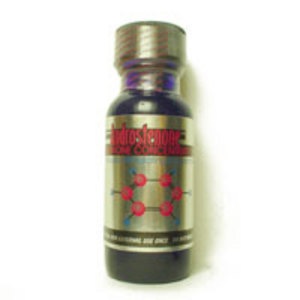Have Sex More!
Get More Dates!
Improve Your Sex Life!
Feel Deliciously Seductive!
While these claims may sound like catchphrases from the subject lines of the spam e-mails we find in our inboxes each day, they’re actually advertisements from the homepages of countless Web-based perfume and cologne manufacturers.
Claims that I, too, would normally dismiss as easily as any other that seem just “too good to be true.” But according to Psychology Professor Norma McCoy of San Francisco State University, she’s done the scientific research to back them up.
Professor McCoy, who has spent the past several decades studying sexuality, was the first researcher to publish a study that independently tested a sex attractant pheromone for women.
Perfume and cologne products laced with “secret seducers,” chemically produced substances designed to mimic our natural patterns of sexual attraction, began to hit the market as early as 1996.
But what are these companies lacing our colognes and perfumes with, you ask? Synthetic pheromones, chemical substances produced naturally by the human body in order to control urges like hunger, thirst, and yes, even sexual arousal.
“Pheromones are secreted externally,” said Professor McCoy. In the simplest terms, they work by causing a change in the reproductive behavior of another person-if you put on synthetic pheromones, for example,” she said, referring directly to me, “they would stimulate the sexual behavior of the men on your campus through their olfactory sensors, causing them to be more sexually attracted to you.
McCoy and a graduate student from the SFSU Psychology department, Lisa Pitino, spent 14 weeks in 2002 testing 36 women recruited from the university, giving one portion a perfume enhanced with the sex attractant pheromone to wear and the rest of the participants one enhanced only with a harmless sugar solution known as a placebo.
“Seventy-four per cent of the group with the pheromone-enhanced perfume reported an increase in a number of sociosexual behaviors,” said McCoy, “including an increased frequency of kissing, sexual fondling, sexual intercourse, and even in the number of formal dates these women were asked on.”
In other words, the women who wore the pheromone-enhanced perfume experienced more or more frequent sexual behaviors and were asked out more often by men.
But as my statistics professor always told me, “Correlation does not imply causation,” a fancy way of saying that the increase in sociosexual behaviors experienced by the women wearing the synthetic pheromones in McCoy’s study doesn’t necessarily mean that it was the pheromones that caused this increase.
Regardless, the popularity of pheromone-enhanced products is clear based on the number of Web-based companies selling these “magic potions” that have cropped up since the product’s arrival on the market.
Googling the word “pheromones” now brings up over a dozen different companies on the first results page alone that are pushing pheromone-enhanced perfumes designed to attract men and colognes with pheromone additives intended to attract women.
So why are people paying for fake versions of the chemicals our bodies naturally produce?
How do pheromones really work?
Human sex pheromones are responsible for preparing the body for reproduction. Sex pheromones work to attract sexual partners by activating certain parts of the human brain. When I picked up this month’s issue of Scientific American Mind, the cover story, titled “Sex and the Secret Nerve: Could a little-known nerve be a key to desire?,” immediately caught my eye.
According to the article, scientists have for decades been keeping the general public in the dark about what may arguably be one of the most important nerves in the human brain, the “zero nerve.”
First discovered in a shark in 1878 by German scientist Gustav Fritsch, nerve zero’s existence was thought to be pure myth until it was discovered in humans in 1913.
Unlike most human nerves, which enter the brain through the hollow cylindrical opening that spans the length of our spinal cord, nerve zero is one of thirteen cranial nerves, entering the brain directly without passing through the spinal cord.
Dubbed nerve “zero” based on its location in the brain-just ahead of the cranial nerve called nerve one (which is just before nerve two, right ahead of nerve three… you get the idea), this cranial nerve has recently been implicated in the process of interpreting the silent chemical messages exchanged by members of the opposite sex and relaying them from the olfactory sensors in our nasal passages directly to the brain.
A tiny nerve sprouting from the base of the human brain, nerve zero is intimately connected to nerve one, the olfactory nerve that controls our sense of smell.
Perfume and cologne products, which work thanks to our sense of smell, are the perfect means of transportation for the synthetic pheromone additives these products boast.
While our olfactory nerve (nerve one) deals with the scents carried by perfume and cologne molecules, its tiny cousin nerve zero receives chemical messages that are actually human sex pheromones.
Sex pheromones, generally excreted in sweat, travel from one person to another in the form of gas molecules (tasteless and odorless, like the oxygen we breathe). The gaseous pheromones travel through the air and are breathed in through the nose, where, according to Professor Fields’ article, they run into the receptive fibers of nerve zero.
Once the pheromone messages reach nerve zero, they travel along the nerve’s fibers from the nasal cavity to what Fields’ calls the “hot-button sex regions of the brain.” When they finally arrive in the brain, the information sent by our little pheromone messengers causes sex hormones to be released throughout the body.
You can guess what happens then.
But isn’t something missing here?
An article featured on WebMD.com makes explicit the apparent link between pheromones and sexual arousal, and between sexual arousal and reproduction.
If human sex pheromones are naturally produced by our bodies in order to attract members of the opposite sex for reasons of reproduction, and synthetic pheromone products exist for both men and women, where do lesbians and gay men fit into this equation?
Even though the testimonials found on Web sites like Luvessentials.com and PherLure.com are from both men and women who have, we’re told, used this or that particular company’s product with “great success!!!,” none of the information on these corporate sites explicitly addresses the issue of homosexuality.
Hoping that what I’d encountered was a mere advertising oversight, I continued my investigation into these magic love potions, looking for any indication that this market was not yet another intended only for the “straight” members of our society.
What I began to find was only slightly comforting.
Pheromones for Men! Pheromones for Women!
Usually sold as two separate products, synthetic pheromones tend to be marketed in one of two ways: as designed for either men or women, or as designed to attract either men or women.
So what is the purpose of these different marketing strategies? Does one type of pheromone product attract men, despite the gender of the wearer? How does sexual orientation fit into the equation?
Fortunately, one study shines some light on the issue.
Researchers Ivanka Savic, Hans Berglund, and Per Lindstr�m conducted a study published in 2005 designed to investigate whether the biologically sex-specific pheromones produced by men and women can be linked to sexual orientation.
The study, performed in Stockholm, Sweden, isolated two types of human hormones (chemicals found in humans that control processes like growth and metabolism) thought to be the primary components of sex pheromones and used them in concentrated doses on same- and opposite-sex individuals.
The Stockholm scientists found that the pheromone compound produced by men to attract a sexual partner, a testosterone derivative called AND (which stands for the much longer and more complicated name “4,16-androstadien-3-one”) caused both straight women and homosexual men to become sexually aroused.
In previous studies, scientists had observed the sex specific effects of AND on the nervous system, mood, and context-dependent sexual arousal of straight women, but the 2005 Swedish study was the first to test these results with regard to homosexual males.
A year later, Savic, Berglund and Lindstr�m were at it again, publishing another research study that focused instead on the effect of a female hormone known as EST (short for “estra-1,3,5[10],16-tetraen-3-ol”), an estrogen-like steroid thought to be the main component of the human sex pheromones produced by women, on homosexual women.
The results of this second study were similar to the first: lesbian participants became sexually aroused when exposed to EST, much the same way as straight men did. Alternately, EST evoked no sexual response in straight women.
Savic, Berglund and Lindstr�m’s research is provocative for several reasons, including its implications for mainstream biological and psychological theory on human sexuality. For our purposes, however, the findings simply mean that lesbians and gay men can claim a fair share of the market when it comes to synthetic pheromone products.
Apparently, the advertising schemes of a number of these perfume and cologne manufacturers just haven’t caught up as far as the implications of such scientific research goes.
Enough science babble: do pheromone products really work?
Even after all of the scientific research, online Web perusal, and the interview with Professor McCoy I was still skeptical about whether products laced with faux human sex hormones would have noticeable effects.
I decided to test out one of these “seductive perfumes” myself.
After looking at the merchandise offered by a number of different Web-based pheromone-enhanced perfume manufacturers, I settled on one called Androstenone, marketed as a double strength “pheromone concentrate” and as “Nature’s only TRUE aphrodisiac” (seemingly contradictory, since the pheromone component of Androstenone, like virtually every other pheromone product on the market, is produced synthetically in a laboratory…).
Based on the price, $29.99, which seemed like a steal compared to the $199.95 price tag of some of the supposedly “higher-end” pheromone products, combined with the fact that the company offers a money-back guarantee (I still wasn’t sold), I placed an order for a very small bottle.
By the time the deep blue, 0.34 millilitre vial of surprisingly pleasant-smelling synthetic pheromones arrived, I had devised my own psudo-experiment for testing out their magical powers.
I decided to go to the local mall on a Friday night, sans pheromones, to observe the reactions of the male shoppers around me. Then, a week later, I’d return to the same mall, wearing the same outfit, visiting the same stores and acting as similarly to the previous Friday evening as possible (so that I would be able to contribute any noticeable differences in behavior to the pheromones, not my clothing or the stores I was in, etc.), but this time I planned to accessorize with a healthy dose of Androstenone and then make the same kinds of observations.
Sounds simple, right? If the faux chemical secret seducers in the perfume worked, then the male mall patrons would arguably pay more attention to me on the second Friday than on the first. If not, it would be d�j� vu all over again.
As I walked around the mall on that second Friday evening wearing my new “sex toy,” I could imagine the little molecular pheromone messengers from my perfume flying through the air, lodging in the nasal passages of the nearest male.
I could imagine his olfactory sensors picking up on the sweet scene of the perfume while the nerve endings of nerve zero were stimulated by the synthetic chemical messengers. A nerve impulse would then travel from zero’s nerve receptors to the sex regions of his brain, what are known to scientists as the medial and lateral septal nuclei and preoptic areas.
In other words, this guy wouldn’t know what hit him.
That certainly seemed to be the case during the second half of my “experiment.” While browsing in different stores, I noticed a significantly larger number of men paying attention to me. Some smiled and said “Hello,” while others got a rather disturbing look in their eye, stared for a minute or two and then walked quickly in the other direction.
To each his own, I guess.
All I know is that I won’t be using that money back guarantee I so carefully sought out when purchasing my own magic pheromone perfume.
Androstenone is here to stay.






